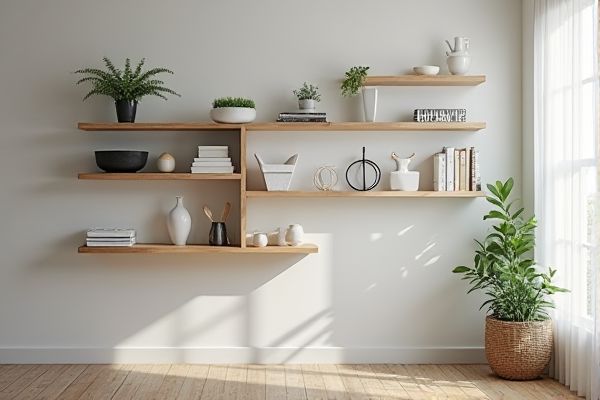
Wall-mounted shelves save floor space and provide a sleek, modern look, ideal for small rooms or minimalist designs. Explore the full article to discover which type suits your storage needs and enhances your room's style.
Table of Comparison
| Feature | Wall-Mounted Shelves | Free-Standing Shelves |
|---|---|---|
| Installation | Requires wall drilling and anchors | No installation needed; ready to use |
| Space Saving | Maximizes floor space | Occupies floor space |
| Mobility | Fixed position | Easy to move and reposition |
| Weight Capacity | Typically higher load capacity | Limited load capacity depending on design |
| Design Variety | Modern, minimalist options | Wide range including bulky and decorative |
| Cost | Usually less expensive but requires tools | Varies; often higher due to materials and size |
| Maintenance | Easy to clean around | Requires cleaning beneath and around |
Introduction to Shelving Solutions
Wall-mounted shelves maximize space efficiency by utilizing vertical wall areas, ideal for small rooms and minimalist designs. Free-standing shelves offer greater mobility and versatility, allowing easy rearrangement and additional storage without installation. Selecting between these options depends on room size, structural support, and functional needs.
Key Differences Between Wall-Mounted and Free-Standing Shelves
Wall-mounted shelves save floor space and offer a sleek, minimalist look by attaching directly to walls, making them ideal for small rooms or showcasing decorative items. Free-standing shelves provide greater flexibility in placement and storage capacity, often offering multiple tiers and easy relocation without wall damage. The material and installation method also differ, with wall-mounted shelves requiring secure anchoring, while free-standing units rely on stability and weight distribution.
Space Efficiency: Making the Most of Your Room
Wall-mounted shelves maximize space efficiency by utilizing vertical wall areas, freeing up floor space for other uses and making rooms appear larger. Free-standing shelves offer flexibility in placement but consume valuable floor space, which can limit room functionality and reduce open areas. Choosing wall-mounted shelves enhances organization without crowding, optimizing small or multifunctional rooms.
Installation: Complexity and Flexibility
Wall-mounted shelves require careful installation involving anchors and studs to ensure stability, offering a fixed and space-saving storage solution ideal for maximizing wall areas without occupying floor space. Free-standing shelves provide greater flexibility, allowing you to easily rearrange or relocate them without the need for permanent fixtures, making them a practical choice for renters or those who frequently update their room layout. Your decision should consider the level of installation effort you're willing to commit and how often you plan to change your storage setup.
Durability and Weight Capacity Comparison
Wall-mounted shelves typically offer higher weight capacity and enhanced durability due to their secure attachment to studs or wall anchors, making them ideal for heavy items like books or kitchenware. Free-standing shelves provide flexibility in placement but often have lower weight limits and may be less stable, especially with taller units. Consider your space and storage needs carefully to choose the right shelf type that ensures longevity and supports the weight of your belongings.
Aesthetic and Design Options
Wall-mounted shelves offer a sleek, minimalist aesthetic that saves floor space and provides a floating effect, making rooms appear larger and more modern. Free-standing shelves come in diverse styles, materials, and heights, allowing greater flexibility in design and easy relocation to suit various interior themes. Both options enhance room decor, but wall-mounted units excel in creating clean lines while free-standing shelves contribute to a more traditional or eclectic look.
Cost Considerations and Budget Planning
Wall-mounted shelves typically cost less due to lower material requirements and installation spaces, making them a budget-friendly option for maximizing vertical storage. Free-standing shelves may involve higher expenses because of their bulkier design and the need for more materials, but they offer greater flexibility in placement and mobility. When planning your budget, consider both upfront costs and long-term value, factoring in your space constraints and storage needs to choose the most cost-effective option.
Ideal Use Cases for Wall-Mounted Shelves
Wall-mounted shelves are ideal for maximizing space in small rooms, providing a sleek, modern look while keeping floors clear of clutter. They are perfect for displaying decorative items, organizing books, or storing kitchen essentials within easy reach without taking up valuable floor space. You benefit from their sturdy installation, which supports heavier items and helps maintain an organized, minimalist environment.
Best Applications for Free-Standing Shelves
Free-standing shelves are ideal for versatile storage needs, offering flexibility in placement and easy relocation in living rooms, offices, or bedrooms. They accommodate larger or heavier items without requiring wall support, making them perfect for books, decorative pieces, or kitchenware. Your space benefits from their adaptability, allowing customization around existing furniture and room layouts.
How to Choose the Right Shelving for Your Needs
Choosing the right shelving depends on your space, weight capacity, and aesthetic preferences. Wall-mounted shelves save floor space and offer a sleek look, ideal for small rooms or focused storage needs, while free-standing shelves provide flexibility and greater storage capacity without installation. Consider your room layout, the items you'll store, and whether you prefer a fixed or movable solution to make the best choice.
 homyna.com
homyna.com